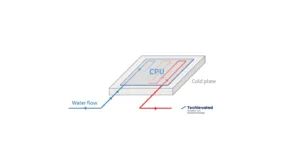
Game On? AI’s Journey Ahead in Video Games
Generative AI for video games is still far from being real. The main challenges are latency of cloud gaming and the very high cost of
At the opening of the 21st century Red Hat succeeded in commercializing a distribution of the open-source Linux operating system for the data center. Like Mark Twain said, history does not repeat itself, but it often rhymes. RISC-V, an open standard instruction set architecture (ISA), could have the potential to mirror the success of Linux two decades later, but in the hardware domain. RISC-V was founded in 2015, and it could challenge the dominance of proprietary architectures like x86 or Arm in the data center. When comparing RISC-V vs Arm, the former offers more flexibility for chip designers without the need of licensing fees. Its open approach aligns with the preferences of major tech players, who generally like to have design freedom and avoid depending on a few single vendors when possible.

Source: all images from Freepik
In the late 90s Linux was just a nascent technology commencing to make a small dent in the server market. Back then it was seen as an operating system for low-end servers focused on basic computing tasks. Microsoft, which was at a crossroads after seeing its share price sink by 50% after the dotcom bubble, was also trying to get a piece of the data center pie.
A company called Red Hat saw an opportunity where others didn’t. The firm had already launched Red Hat Linux, an open-source and free distribution of Linux, which had been gaining adoption. Open-source software was getting popular among programmers who wanted a low-cost and flexible operating system.
Red Hat however came up with a disruptive idea. Why not make a commercial product based on an open-source distribution? Users would still enjoy freedom and flexibility to run applications in a wide range of hardware but would pay Red Hat for customer support. Although this initially seemed to be against the principles of open-source software, the firm launched Red Hat Enterprise Linux in 2001, and it ended up being a terrific success. In 2019 Red Hat generated more than $2 billion from this product, just before being acquired by IBM for $34 billion.

Source: Freepik
The data center has traditionally been powered with chips that use Intel´s proprietary x86 architecture. A chip architecture (instruction set architecture, or ISA) refers to the set of instructions understood by the CPU or processor. Think about loading or storing data, adding or multiplying. x86 processors are built with a CISC architecture (Complex Instruction Set Computer). They normally have higher raw performance than their RISC (Reduced Instruction Set Computer) counterparts, albeit at a higher power consumption. Arm (a proprietary RISC architecture) has recently begun to make a dent in Intel and AMD´s (x86) domination in the data center, with a 10% market share according to Arm´s IPO filings.
The issue with proprietary architectures is chip designers and hyperscalers are left with little choice when choosing vendors, normally locked in with one of them. A processor’s performance can be significantly improved by making adjustments to the architecture, but proprietary ISAs normally do not allow it. This is where RISC-V kicks in.
RISC-V is an open standard ISA founded in 2015. In contrast to other architectures, chip designers can use and modify the ISA at their own will without having to pay anyone. They can modify existing instructions or add their own custom ones, which adds a lot of flexibility. It is the equivalent of having an architectural license agreement with Arm or Intel, but free.

Firms can also make commercial use of RISC-V, as RedHat did with Linux: they can develop their own proprietary chip designs and sell them. The main difference is that, even if you end up purchasing chips from someone else, you can choose among a wide range of vendors, contrary to what happens with proprietary ISAs, where you are locked in with one provider. Hyperscalers and big tech companies don’t like to be dependent on a single provider for any of their products as this reduces their bargaining power, so RISC-V could be a good alternative for many of them. Based on this, RISC-V could thrive in the years to come in the data center environment like its software counterpart Linux already did two decades ago.
Some RISC-V data center chiplets have already been launched, like Ventana Micro Systems Veyron V2 or Tenstorrent´s Ascalon RISC-V processors. The main barrier is that for the hardware to be deployed at scale, the ecosystem needs to keep growing. There are a lot of tools needed to make a server processor work: software, firmware, power optimization or cybersecurity are just a few. Work is also being done on this front, as the Linux Europe Foundation launched RISE in May 2023, an initiative to bring together vendors to accelerate the availability of software for RISC-V. Participants include some important players like Google, MediaTek, Nvidia, Qualcomm and… Red Hat.
Only the future will tell if RISC-V succeeds in the data center, but we could say it has a good chance.

Generative AI for video games is still far from being real. The main challenges are latency of cloud gaming and the very high cost of

RISC-V, an open standard instruction set architecture (ISA), could have the potential to mirror the success of Linux two decades later, but in the hardware domain.

GPU vs CPU is a parallelization vs complexity dilemma. While GPUs can manage very large parallel calculations, they struggle with linear, more heterogeneous tasks, where CPUs excel.

AI workloads require more server density and generate more heat. Direct-to-chip liquid cooling is emerging as the preferred cooling solution for AI with leaders like Meta, Google or Equinix adopting it.

Smartphone on-device AI is expected by 2024, and will likely be combined with cloud AI. Smartphone makers will capitalize on it by increasing prices.

SaaS requires less investment in hardware, is simpler and facilitates scalability. On-premise allows for more customization but management is more complex.
The information provided on this site is for informational purposes only. The content is based on the authors´ knowledge and research at the time of writing. It is not intended as professional advice or a substitute for professional consultation. Readers are encouraged to conduct their own research and consult with appropriate experts before making any decisions based on the information provided. The blog may also include opinions that do not necessarily reflect the views of the blog owners or affiliated individuals. The blog owners and authors are not responsible for any errors or omissions in the content or for any actions taken in reliance on the information provided. Additionally, as technology is rapidly evolving, the information presented may become outdated, and the blog owners and authors make no commitment to update the content accordingly.